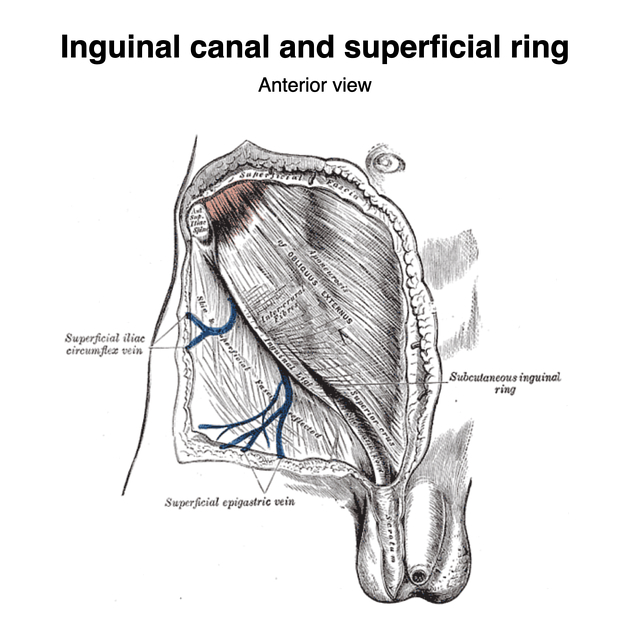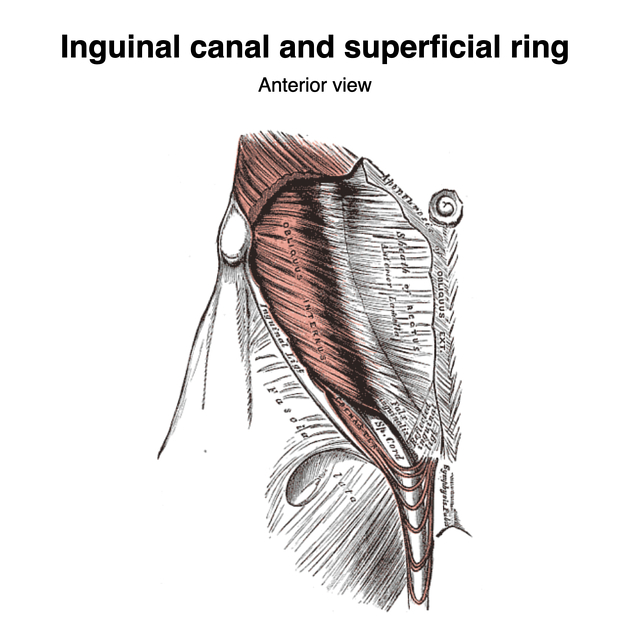Inguinal canal
Citation, DOI, disclosures and article data
At the time the article was created Henry Knipe had no recorded disclosures.
View Henry Knipe's current disclosuresAt the time the article was last revised Craig Hacking had the following disclosures:
- Philips Australia, Paid speaker at Philips Spectral CT events (ongoing)
These were assessed during peer review and were determined to not be relevant to the changes that were made.
View Craig Hacking's current disclosures- Superficial inguinal ring
- Deep inguinal ring
- Inguinal ring
- Abdominal inguinal ring
- Subcutaneous inguinal ring
The inguinal canal is a passage in the anterior abdominal wall that transmits structures from the pelvis to the perineum formed by the fetal migration of the gonad from the abdomen into the labioscrotal folds.
Gross anatomy
The inguinal canal has an oblique course, is 4 cm in length and has two openings:
- deep inguinal ring: a round opening in the transversalis fascia found 1 cm superior to the inguinal ligament and 1 cm lateral to the inferior epigastric arteries
- superficial inguinal ring: a V-shaped opening in the external oblique aponeurosis that is superior and lateral to the pubic tubercle (within Hesselbach's triangle) 1,2
Deep inguinal ring
The deep inguinal ring is bounded by the following:
- laterally by the angle between the transversus abdominis and inguinal ligament
- medially lies the inferior epigastric vessels
Older authors and texts refer to the deep ring as the abdominal inguinal ring.
Superficial inguinal ring
The superficial inguinal ring, as described, is an inverted "V" shaped, triangular opening in the medial end of the external oblique aponeurosis, above and lateral to the pubic tubercle. The lateral arm of the "V" is the lateral crus and its medial arm, the medial crus. The spermatic cord (in males)/round ligament (in females) overlies the pubic tubercle.
- lateral crus of the "V" is attached to the pubic tubercle
- medial crus of the "V" is attached to the pubic crest, near the symphysis
- posterior crus arises from the attachment of the lateral crus, whereby some fibers (reflected part of the inguinal ligament) pass up behind the cord to attach to the rectus sheath, blending with fibers of the opposite side
Older authors and texts refer to the superficial ring as the subcutaneous inguinal ring.
Boundaries
The following structures contribute to the walls of the inguinal canal 1:
- superior wall (roof): internal oblique muscle and transversus abdominis muscle
- anterior wall: external oblique aponeurosis and internal oblique aponeurosis
- inferior wall (floor): inguinal ligament and lacunar ligament
- posterior wall: transversalis fascia and conjoint tendon
MALT is a mnemonic to recall this.
Contents
- males & females: ilioinguinal nerve 1,2, genital branch of genitofemoral nerve
- males: spermatic cord (and contents)
- females: round ligament
ADVERTISEMENT: Supporters see fewer/no ads
Related pathology
References
- 1. Bhosale PR, Patnana M, Viswanathan C et-al. The inguinal canal: anatomy and imaging features of common and uncommon masses. Radiographics. 2008;28 (3): 819-35. Radiographics (full text) - doi:10.1148/rg.283075110 - Pubmed citation
- 2. Shadbolt CL, Heinze SB, Dietrich RB. Imaging of groin masses: inguinal anatomy and pathologic conditions revisited. Radiographics. 2001;21 Spec No: S261-71. Pubmed citation
Incoming Links
- Pantaloon hernia
- Groin herniation
- Inguinal hernia
- Inferior epigastric artery
- Round ligament varicosities
- Cremasteric artery
- Lateral crescent sign (inguinal hernia)
- Round ligament of the uterus
- External oblique muscle
- Iliohypogastric nerve
- Richter hernia
- Littré hernia
- Genitofemoral nerve
- Vasitis
- Spigelian-cryptorchidism syndrome
- Canal of Nuck
- Interfoveolar ligament
- Transversalis fascia
- Hydrocele of the canal of Nuck
- Lateral fossa
- Post-herniorrhaphy neuralgia
- Rupert Bear (Rorschach radiology)
- Spermatic cord haematoma
- Hernia uterine inguinale
- Polyorchidism
- Amyand hernia with undescended testis
- Large bowel obstruction due to incarceration in femoral hernia
- Testicular yolk sac tumor
- Atrophic testis
- Prostate cancer with metastatic lymph nodes
- Indirect inguinal hernia with distal large bowel obstruction
- Labial lipoma - large
- Inguinal canal and rings (Gray's illustrations)
- Lipoblastoma - inguinal canal
- Bilateral funiculocele
- Inguinoscrotal hernia
- Inguinal canal (diagram)
Related articles: Anatomy: Abdominopelvic
- skeleton of the abdomen and pelvis
- muscles of the abdomen and pelvis
- spaces of the abdomen and pelvis
- anterior abdominal wall
- posterior abdominal wall
- abdominal cavity
- pelvic cavity
- perineum
- abdominal and pelvic viscera
- gastrointestinal tract
- spleen
- hepatobiliary system
-
endocrine system
-
adrenal gland
- adrenal vessels
- chromaffin cells
- variants
- pancreas
- organs of Zuckerkandl
-
adrenal gland
-
urinary system
-
kidney
- renal pelvis
- renal sinus
- avascular plane of Brodel
-
variants
- number
- fusion
- location
- shape
- ureter
- urinary bladder
- urethra
- embryology
-
kidney
- male reproductive system
-
female reproductive system
- vulva
- vagina
- uterus
- adnexa
- Fallopian tubes
- ovaries
- broad ligament (mnemonic)
- variant anatomy
- embryology
- blood supply of the abdomen and pelvis
- arteries
-
abdominal aorta
- inferior phrenic artery
- celiac artery
- superior mesenteric artery
- middle suprarenal artery
- renal artery (variant anatomy)
- gonadal artery (ovarian artery | testicular artery)
- inferior mesenteric artery
- lumbar arteries
- median sacral artery
-
common iliac artery
- external iliac artery
-
internal iliac artery (mnemonic)
- anterior division
- umbilical artery
- superior vesical artery
- obturator artery
- vaginal artery
- inferior vesical artery
- uterine artery
- middle rectal artery
-
internal pudendal artery
- inferior rectal artery
-
perineal artery
- posterior scrotal artery
- transverse perineal artery
- artery to the bulb
- deep artery of the penis/clitoris
- dorsal artery of the penis/clitoris
- inferior gluteal artery
- posterior division (mnemonic)
- variant anatomy
- anterior division
-
abdominal aorta
- portal venous system
- veins
- anastomoses
- arterioarterial anastomoses
- portal-systemic venous collateral pathways
- watershed areas
- arteries
- lymphatics
- innervation of the abdomen and pelvis
- thoracic splanchnic nerves
- lumbar plexus
-
sacral plexus
- lumbosacral trunk
- sciatic nerve
- superior gluteal nerve
- inferior gluteal nerve
- nerve to piriformis
- perforating cutaneous nerve
- posterior femoral cutaneous nerve
- parasympathetic pelvic splanchnic nerves
- pudendal nerve
- nerve to quadratus femoris and inferior gemellus muscles
- nerve to internal obturator and superior gemellus muscles
- autonomic ganglia and plexuses









 Unable to process the form. Check for errors and try again.
Unable to process the form. Check for errors and try again.